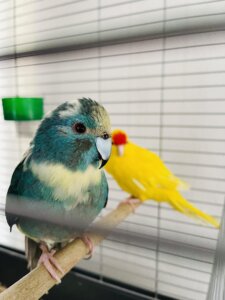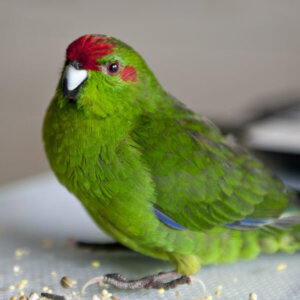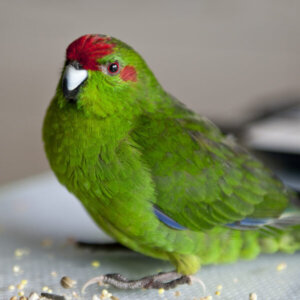Can Kakarikis Live With Budgies: A Harmony Guide
Yes, Kakarikis can live with Budgies. They often get along well if introduced properly and given enough space.
Bird lovers often wonder if Kakarikis and Budgies can share a cage. These two bird species can indeed coexist peacefully. Both are active and playful, which can make for a lively environment. But, like all pets, they need proper care and attention.
Ensuring they have ample space, toys, and separate feeding areas can help reduce any potential conflicts. Understanding their behavior and needs is key to their harmonious living. In this blog, we will explore how to make this cohabitation successful.
Introduction To Kakarikis And Budgies
Are you considering keeping Kakarikis and Budgies together? Understanding their traits is essential for a harmonious cohabitation. Both these birds have unique qualities. Let’s explore their characteristics.
Kakariki Characteristics
Kakarikis, also known as New Zealand parakeets, are lively and curious. These birds are known for their vibrant green feathers and red crowns. They are intelligent and can learn to mimic sounds. Kakarikis are active and require a lot of space to move around.
- Size: 10-11 inches
- Life span: 5-10 years
- Diet: Fruits, vegetables, seeds
- Behavior: Playful, curious, social
They enjoy exploring their environment and need toys to stay entertained. Kakarikis are generally friendly but can be territorial. They thrive in environments where they have plenty of mental and physical stimulation.
Budgie Traits
Budgies, also known as parakeets, are popular pets due to their small size and friendly nature. They come in a variety of colors and patterns. These birds are social and enjoy interacting with their owners.
- Size: 7-8 inches
- Life span: 7-15 years
- Diet: Seeds, fruits, vegetables
- Behavior: Social, playful, vocal
Budgies are known for their ability to mimic human speech. They are active and enjoy flying. Budgies need a cage with ample space and toys to keep them occupied. They are gentle birds but can become stressed if their environment is not stable.
| Characteristics | Kakarikis | Budgies |
|---|---|---|
| Size | 10-11 inches | 7-8 inches |
| Life Span | 5-10 years | 7-15 years |
| Diet | Fruits, vegetables, seeds | Seeds, fruits, vegetables |
| Behavior | Playful, curious, social | Social, playful, vocal |

Credit: www.reddit.com
Comparing Temperaments
Choosing the right companions for your pet birds can be tricky. Understanding the temperaments of Kakarikis and Budgies is essential. Both birds have distinct behaviors that affect their compatibility.
Kakariki Behavior
Kakarikis are known for their active and playful nature. They love to explore and need a lot of space to move around. These birds are curious and can sometimes get into mischief.
- Highly energetic
- Curious and playful
- Can be territorial
They are not very aggressive but can be territorial, especially in smaller spaces. Kakarikis enjoy interacting with their environment and need mental stimulation.
Budgie Behavior
Budgies, on the other hand, are social and friendly birds. They enjoy the company of other birds and humans. Budgies are less likely to be territorial compared to Kakarikis.
- Social and friendly
- Enjoys company
- Less territorial
They are gentle and can coexist with other birds if introduced properly. Budgies thrive on social interaction and enjoy playing with toys and other birds.
| Behavior Traits | Kakarikis | Budgies |
|---|---|---|
| Energy Level | High | Moderate |
| Social Behavior | Curious | Friendly |
| Territorial Nature | Moderate | Low |
Understanding these differences helps in determining their compatibility. Both birds can live together if their needs are met.
Housing Considerations
Housing considerations are crucial for keeping Kakarikis and Budgies together. Both birds have specific needs that must be met to ensure a harmonious living environment.
Cage Size Requirements
A spacious cage is essential for both Kakarikis and Budgies. Kakarikis are very active and need room to move and play. Aim for a cage at least 36 inches wide, 24 inches deep, and 24 inches high. This size allows for adequate space to prevent territorial disputes.
Budgies also benefit from a larger cage. They enjoy flying and playing. A bigger cage reduces stress and promotes healthy behaviors in both species. Ensure the cage bars are close enough to prevent escape. Bars spaced 1/2 inch apart are ideal.
Environmental Enrichment
Both Kakarikis and Budgies need mental and physical stimulation. Provide a variety of toys, perches, and swings. Rotate toys regularly to keep them engaged. Natural wood perches help keep their feet healthy.
Foraging toys are a great addition. They mimic natural behaviors and keep the birds busy. Place them at different heights and locations within the cage. This encourages exploration and exercise.
Include items like ladders and ropes. These provide climbing opportunities and enhance physical activity. Ensure all materials are bird-safe and non-toxic.

Credit: www.reddit.com
Diet And Nutrition
Understanding the dietary needs of Kakarikis and Budgies is crucial. These birds have specific nutrition requirements. A balanced diet ensures their health and happiness.
Kakariki Dietary Needs
Kakarikis need a diverse diet. They thrive on fresh fruits and vegetables. Apples, carrots, and leafy greens are great choices. They also enjoy seeds and pellets. A varied diet helps meet their nutritional needs.
Budgie Dietary Needs
Budgies have different dietary needs. They mainly eat seeds and grains. Fresh vegetables are also important for them. Spinach and broccoli are excellent choices. Occasionally, offer them fruits like apples and bananas.
Both Kakarikis and Budgies need fresh water daily. Always ensure their food is clean and fresh. A balanced diet promotes their overall well-being.
Socialization Tips
Ensuring a harmonious living environment for Kakarikis and Budgies requires thoughtful socialization. Follow these tips to help your birds cohabit peacefully.
Introducing New Birds
Introducing new birds can be a delicate process. Start by placing their cages in the same room but at a distance. This allows them to get used to each other’s presence without direct contact.
Gradually move the cages closer over several days. Observe their reactions. Look for signs of interest or aggression. If they seem comfortable, proceed to the next step.
Allow supervised out-of-cage time together in a neutral space. This helps them interact in a controlled environment. Ensure there are no objects that could cause territorial disputes.
Building Positive Interactions
Encourage positive interactions by rewarding calm behavior. Use treats and praise when they are near each other without showing aggression.
Provide toys and perches to keep them entertained. This reduces the chances of conflicts due to boredom.
Spend quality time with both birds. This ensures they do not feel neglected and reduces jealousy.
Separate them immediately if you notice signs of fighting. Give them time to calm down before reintroducing.
Ensuring Each Bird’s Needs Are Met
Ensure each bird has their own space within the shared environment. Separate feeding stations and water sources prevent competition.
Provide multiple perches and nesting areas. This minimizes territorial behavior.
Monitor their health regularly. Stress from new social dynamics can affect their well-being. Look for changes in eating habits or behavior.
Consult an avian vet if you notice any health issues. Professional advice can help address specific concerns.
Health And Safety
Ensuring the health and safety of both Kakarikis and Budgies is crucial. These two birds can cohabit peacefully if their needs are met. This involves monitoring their health and preventing conflicts in their shared space.
Common Health Issues
Both Kakarikis and Budgies can suffer from common avian diseases. These include respiratory infections, mites, and feather plucking. Keeping a clean environment reduces these risks.
Here is a table outlining some common health issues and their symptoms:
| Health Issue | Symptoms |
|---|---|
| Respiratory Infections | Sneezing, nasal discharge, coughing |
| Mites | Itching, feather loss, red skin |
| Feather Plucking | Bald spots, irritated skin, excessive grooming |
Regular vet check-ups help catch and treat these issues early. Always observe your birds for any signs of illness.
Preventing Conflicts
Preventing conflicts is key to their well-being. Follow these tips to maintain harmony:
- Separate feeding areas: Offer food and water in different spots.
- Provide ample space: Ensure the cage is large enough for both birds.
- Monitor interactions: Watch how they interact, especially initially.
- Offer toys and perches: Keep them engaged and reduce boredom.
If conflicts arise, separate them temporarily. This gives them time to calm down. Gradually reintroduce them under supervision.
Activities And Enrichment
Providing activities and enrichment for Kakarikis and Budgies is important. These birds are playful and curious. Keeping them entertained ensures their happiness. It also prevents boredom and stress. Here are some ways to engage them.
Toys And Games
Toys are essential for both Kakarikis and Budgies. They love chewing and shredding toys. Provide a variety of these toys. Rotate them weekly to keep things fresh. Puzzle toys can also be great. They challenge their minds and provide stimulation. Simple DIY toys, like paper rolls, can work well too.
Exercise Opportunities
Exercise is crucial for these active birds. Ensure they have space to fly. A large cage or aviary is ideal. Let them out for free flight daily. Set up perches and swings. This encourages movement and fun. Climbing toys are also great. They help in building strength and agility. You can even create a small playground for them.
Signs Of Compatibility
Determining if Kakarikis and Budgies can live together involves observing their interactions and adjusting to their coexistence. Understanding these signs helps in ensuring a harmonious living environment for both species.
Observing Interactions
To assess compatibility, start by observing how Kakarikis and Budgies interact. Look for these signs:
- Peaceful cohabitation: Both birds should be calm around each other.
- Mutual respect: They should show no signs of aggression.
- Shared space: Both birds should feel comfortable sharing their space.
If you notice any aggressive behavior, separate them immediately. The safety of each bird is paramount.
Adjusting To Coexistence
Once initial interactions are positive, focus on adjusting to coexistence. Follow these steps:
- Gradual introduction: Slowly increase the time they spend together.
- Separate feeding: Ensure each bird has its own feeding area to avoid conflicts.
- Monitor behavior: Keep an eye on their behavior for any signs of stress.
Adjust their environment as needed to maintain harmony. Use separate perches and toys to prevent territorial disputes.

Credit: m.youtube.com
Frequently Asked Questions
Can Kakarikis And Budgies Live Together?
Yes, Kakarikis and Budgies can live together if they are introduced properly. Monitor their interactions closely to ensure compatibility and avoid any potential aggression.
Are Kakarikis And Budgies Compatible?
Kakarikis and Budgies can be compatible if they have enough space. Ensure they have separate feeding areas to minimize conflicts.
What Size Cage For Kakarikis And Budgies?
A large cage is necessary for both Kakarikis and Budgies. Ensure the cage allows them to fly and have separate zones.
Do Kakarikis And Budgies Require Different Diets?
Yes, Kakarikis and Budgies have different dietary needs. Provide a varied diet with seeds, fruits, and vegetables for both species.
Conclusion
Kakarikis and budgies can live together under the right conditions. They need plenty of space and individual attention. Monitor their interactions closely at first. Some birds may not get along. Provide separate feeding areas to reduce conflicts. Always ensure both birds feel safe and comfortable.
Happy, well-cared-for birds make great companions. With patience and care, your budgies and Kakarikis can coexist peacefully.
Hello Dear, I'm Poli Kolymnia, owner of many birds (including budgies).
With a deep passion for these feathered companions, I'm here to share my expertise and extensive knowledge on birds care.
My articles cover essential topics like diet, housing, care, and health, providing practical tips to help you create a happy and thriving environment for your birds.






